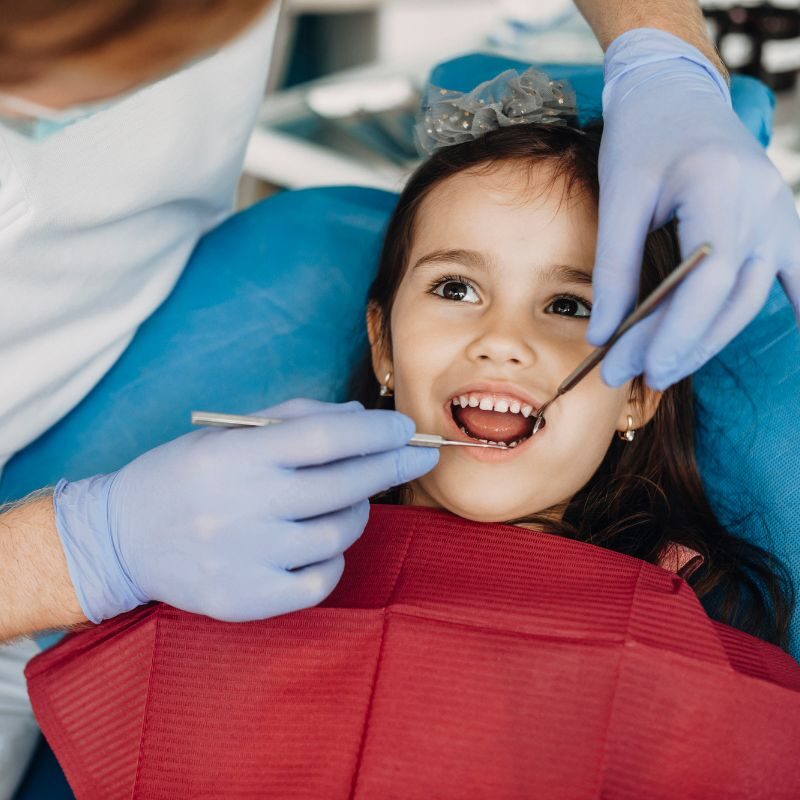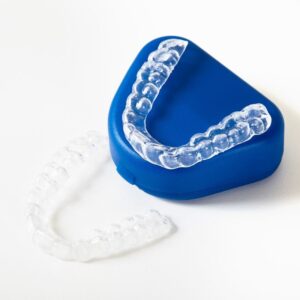Orthodontic treatment is about more than just achieving a beautiful smile; it’s about improving your overall oral health and well-being. Many people wonder, “When to see an orthodontist?” The answer isn’t always straightforward, as orthodontic needs can arise at various stages of life, from childhood to adulthood. Understanding the optimal time for an orthodontic evaluation can make a significant difference in the effectiveness and duration of treatment.
This comprehensive guide will explore the key indicators that suggest it might be time to consult with an orthodontist, dispelling common myths and providing clear, actionable advice. We’ll delve into the benefits of early intervention for children, the unique considerations for teenagers, and the growing trend of adult orthodontics. By the end of this post, you’ll have a clearer understanding of when to seek professional orthodontic care and how it can positively impact your life.
Early Signs: When to See an Orthodontist for Your Child
Many parents wonder about the ideal age for their child’s first orthodontic visit. The American Association of Orthodontists recommends that children have their first orthodontic evaluation by age seven. While this might seem early, it’s a crucial time because permanent teeth have started to emerge, and the orthodontist can assess jaw growth and tooth development. Early detection of potential issues can prevent more complex problems down the line, often leading to simpler and less invasive treatments. For instance, an orthodontist can identify issues like crossbites, severe crowding, or habits like thumb-sucking that could impact dental development. Addressing these concerns early can guide the growth of the jaw and erupting permanent teeth, potentially avoiding the need for extractions or more extensive surgeries in the future. It’s not always about immediate treatment; sometimes, it’s about monitoring and planning for the right time to intervene. This initial visit is typically observational, providing parents with valuable insights into their child’s oral development and a roadmap for future care. It’s about proactive health management, ensuring that any emerging issues are caught before they become significant challenges. So, if you’re asking yourself when to see an orthodontist for your child, age seven is a good benchmark for that initial assessment.
Common Childhood Orthodontic Concerns
Several common issues in children warrant an orthodontic evaluation. These include early or late loss of baby teeth, difficulty chewing or biting, mouth breathing, thumb sucking or finger sucking habits, crowded or misplaced teeth, jaws that shift or make sounds, and teeth that don’t meet properly. Protruding teeth, often a result of an overbite, can also be a concern, as they are more susceptible to injury. Additionally, if you notice any speech impediments that seem related to dental alignment, or if your child’s jaw appears disproportionate to their face, these are all valid reasons to seek an orthodontic opinion.
An orthodontist can differentiate between normal developmental stages and true orthodontic problems, providing peace of mind or a clear path forward. They can also address habits that might be contributing to dental misalignment, offering solutions and guidance to help children break these patterns. Understanding these common concerns can help parents identify when to see an orthodontist for their child’s specific needs, ensuring they receive timely and appropriate care for a healthy smile that lasts a lifetime.
Teenagers and Orthodontics: Navigating the Adolescent Years
Adolescence is a common period for orthodontic treatment, primarily because most permanent teeth have erupted, and growth spurts can be strategically utilized to achieve optimal results. While some issues might have been identified during earlier evaluations, many orthodontic problems become more apparent during the teenage years. This is often when aesthetic concerns become more prominent for individuals, as they become more self-aware of their appearance. Beyond aesthetics, functional issues such as difficulty chewing, speech impediments, or jaw pain can also emerge or worsen during this time. Orthodontic treatment during adolescence can address a wide range of concerns, from correcting misaligned bites to closing gaps between teeth or alleviating overcrowding.
The teenage years also offer a unique advantage: the jawbones are still developing, making them more responsive to orthodontic forces. This can lead to more efficient treatment outcomes compared to adult orthodontics, where jaw growth has ceased. Furthermore, teenagers are often more receptive to wearing braces or aligners, as many of their peers may also be undergoing similar treatments, creating a sense of shared experience. Understanding these factors is key when considering when to see an orthodontist for a teenager, as timely intervention can set the stage for a lifetime of healthy smiles.
Common Orthodontic Solutions for Teens
For teenagers, the options for orthodontic treatment are diverse and can be tailored to individual needs and preferences. Traditional metal braces remain a highly effective and popular choice, known for their durability and ability to correct complex cases. However, advancements in orthodontics have introduced more discreet alternatives, such as clear braces, which are less noticeable due to their translucent brackets. Clear aligners, like Invisalign, have also become increasingly popular among teenagers who prefer a removable and virtually invisible treatment option. These aligners offer flexibility, allowing teens to eat their favorite foods without restrictions and maintain oral hygiene more easily.
Custom braces, designed with advanced digital imaging and 3D treatment planning, provide a personalized approach, often leading to more precise and efficient results. Retainer therapy is also a critical component of teenage orthodontic treatment, ensuring that the achieved results are maintained long-term. The choice of treatment depends on the specific orthodontic issues, the teenager’s lifestyle, and their commitment to treatment compliance. A consultation with an experienced orthodontist can help determine the most suitable solution, guiding both parents and teens through the decision-making process and ensuring a successful orthodontic journey.
Adult Orthodontics: It’s Never Too Late for a Straight Smile
Gone are the days when orthodontic treatment was solely associated with childhood or adolescence. Today, a significant number of adults are seeking orthodontic care, recognizing that it’s never too late to achieve a healthy, beautiful smile. The reasons for adult orthodontics are varied, ranging from addressing issues that were never corrected in youth to new problems that have emerged over time, such as shifting teeth due to gum disease or tooth loss.
Many adults also seek treatment for aesthetic reasons, desiring a more confident smile for personal and professional interactions. Beyond cosmetics, adult orthodontics can significantly improve oral health by correcting bite problems that contribute to jaw pain, difficulty chewing, excessive wear on teeth, or even sleep apnea. Modern orthodontic techniques and technologies have made treatment more comfortable, efficient, and discreet than ever before, appealing to the busy lifestyles of adults. The decision to pursue adult orthodontics is often a personal one, driven by a desire for improved health, function, and self-esteem. Understanding the benefits and available options is crucial when considering when to see an orthodontist as an adult, as it can open the door to a healthier and more confident future.
Popular Adult Orthodontic Options
Adults have a wide array of orthodontic options available, many of which are designed to be less noticeable and more convenient for their lifestyles. Clear aligners, such as Invisalign, are particularly popular among adults due to their nearly invisible appearance and removability. This allows adults to maintain their professional image and enjoy their favorite foods without restrictions and maintain oral hygiene more easily.
Lingual braces, which are placed on the inside surface of the teeth, offer another discreet option, though they may require a longer adjustment period. For those who prefer fixed appliances, ceramic braces provide a less conspicuous alternative to metal braces, as their clear or tooth-colored brackets blend in with the natural teeth. Even traditional metal braces have evolved, becoming smaller and more comfortable than in the past. The choice of treatment depends on the complexity of the case, the patient’s aesthetic preferences, and their commitment to treatment compliance. An experienced orthodontist can assess individual needs and recommend the most suitable treatment plan, ensuring that adults can achieve their desired smile goals effectively and efficiently. It’s about finding the right solution that fits seamlessly into an adult’s life, making the journey to a straighter smile both achievable and enjoyable.
Beyond Aesthetics: The Health Benefits of Orthodontic Treatment
While a beautiful, straight smile is often the most visible outcome of orthodontic treatment, the benefits extend far beyond aesthetics. Correcting misaligned teeth and jaws can significantly improve overall oral health and prevent a host of potential problems. For instance, properly aligned teeth are easier to clean, reducing the risk of plaque buildup, cavities, and gum disease. When teeth are crowded or crooked, brushing and flossing become more challenging, creating areas where bacteria can thrive. Orthodontic treatment can also alleviate issues related to an improper bite, such as difficulty chewing, speech impediments, and excessive wear on tooth enamel. An uneven bite can place undue stress on certain teeth, leading to premature wear, chipping, or even fractures.
Furthermore, correcting bite problems can reduce strain on the temporomandibular joint (TMJ), which can alleviate chronic headaches, jaw pain, and facial discomfort. In some cases, orthodontic treatment can even improve breathing patterns, particularly in individuals with certain types of jaw misalignment that contribute to sleep apnea. It’s about creating a harmonious balance within the oral system, ensuring that teeth, jaws, and muscles work together efficiently. These health benefits underscore the importance of seeking orthodontic care not just for cosmetic reasons, but for a lifetime of improved oral function and well-being. So, when considering when to see an orthodontist, remember that the advantages go much deeper than just a pretty smile.
Long-Term Impact on Oral Health
The long-term impact of orthodontic treatment on oral health is profound and far-reaching. By addressing underlying issues of misalignment, orthodontics can help prevent future dental problems that might otherwise require more extensive and costly interventions. For example, correcting an open bite can prevent tongue thrusting habits, while fixing an overbite can protect the lower front teeth from excessive wear caused by contact with the upper teeth. A properly aligned bite distributes chewing forces evenly across all teeth, reducing the risk of damage and preserving the integrity of your natural dentition.
Moreover, a healthy bite can contribute to better digestion, as food is more effectively broken down during chewing. The stability achieved through orthodontic treatment also plays a crucial role in maintaining the results of other dental procedures, such as fillings, crowns, or implants. When teeth are in their correct positions, they are less likely to shift or relapse after restorative work. Ultimately, investing in orthodontic care is an investment in your long-term oral health, providing a foundation for a healthy, functional, and beautiful smile that can last a lifetime. It’s a proactive approach to dental care that yields dividends for years to come, making the decision of when to see an orthodontist a clear choice for a healthier future.
The Chacon Orthodontics Difference: Advanced Technology and Patient-Centered Care
At Chacon Orthodontics, the commitment to exceptional patient care is evident in every aspect of their practice, from the moment you step through the door to the completion of your treatment. Dr. Omar Chacon, a board-certified orthodontist with over 10 years of experience, leads a team dedicated to providing personalized and effective orthodontic solutions. His extensive education from the University of Puerto Rico and advanced training in New York City ensure that patients receive care grounded in the latest research and techniques. Beyond the expertise of the team,
Chacon Orthodontics distinguishes itself through its embrace of advanced technology. Digital imaging allows for precise diagnostics and treatment planning, reducing radiation exposure and providing a clearer picture of your oral anatomy. 3D treatment planning takes this a step further, enabling the creation of highly customized treatment paths that are both efficient and effective. This technology allows patients to visualize their treatment journey and the anticipated results, fostering a greater understanding and engagement in their care. Custom appliances are also a hallmark of their approach, ensuring that each patient receives a solution perfectly tailored to their unique needs. This blend of experienced professionals and cutting-edge technology ensures that every patient receives the highest standard of care, making the decision of when to see an orthodontist an easy one when considering Chacon Orthodontics.
A Personalized Approach to Your Smile Journey
What truly sets Chacon Orthodontics apart is its unwavering dedication to patient-centered care. They understand that every smile journey is unique, and they strive to create a comfortable, welcoming, and supportive environment for all their patients. Being bilingual (English/Spanish) allows them to communicate effectively with a diverse patient base, ensuring that language is never a barrier to understanding treatment options and progress. Flexible scheduling options are available to accommodate busy lifestyles, making it easier for patients to attend appointments without disrupting their daily routines. Furthermore, Chacon Orthodontics accepts various insurance plans, working to make quality orthodontic care accessible and affordable. The team takes the time to listen to patient concerns, answer questions thoroughly, and explain every step of the treatment process in clear, understandable terms. This personalized approach fosters trust and empowers patients to make informed decisions about their oral health. It’s not just about straightening teeth; it’s about building relationships and ensuring a positive experience throughout the entire orthodontic journey. This commitment to comprehensive, compassionate care is a significant factor when considering when to see an orthodontist, as it ensures that your experience will be as positive and stress-free as possible.
Conclusion
Deciding when to see an orthodontist is a crucial step towards achieving and maintaining optimal oral health. Whether you’re considering treatment for yourself or a loved one, recognizing the signs and understanding the benefits of timely intervention are paramount. From early childhood evaluations to adult orthodontic solutions, Dr. Omar Chacon and the experienced team at Chacon Orthodontics are dedicated to providing patient-centered care with advanced technology and a friendly, approachable tone.
We offer a range of services, including clear aligners, custom braces, traditional braces, retainer therapy, and teeth whitening, all designed to help you achieve your healthiest, most confident smile. Don’t let questions about your orthodontic health linger. We invite you to schedule a free consultation at one of our convenient locations: 510 Westbrook Ave, Brandon, or 13019 W Linebaugh Ave, Suite 102, Westchase.
Discover how Chacon Orthodontics can transform your smile and enhance your quality of life. When to see an orthodontist? The best time is now to start your journey towards a healthier, happier you.







